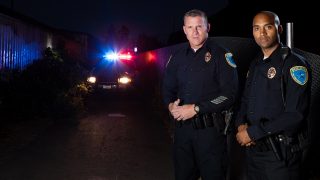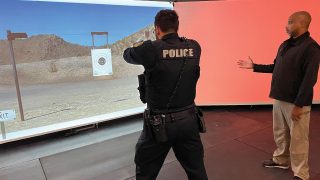
De-escalation can be a foggy term. On the one hand, it refers to gaining control over an enforcement situation that is threatening to become uncontrollable. On the other, it refers to gaining voluntary compliance from the person contributing to the potentially uncontrollable situation. These goals can seem contradictory in practice, but they are clearly meant to be achieved together. According to the Seattle Police Department’s de-escalation policy, de-escalation tactics “seek to minimize the likelihood of the need to use force during an incident and increase the likelihood of voluntary compliance.” Adding to the fog is that there is no accepted standard of practice, and how to de-escalate varies across the board. Some officers use tools like tasers and body wrap, and others use verbal judo. When we think of de-escalation as a matter of conflict resolution — resolving the conflict behavior that drives the growing intensity of an enforcement situation — it becomes easier to stay focused in escalating encounters and draw on nonviolent communication skills to maintain control and secure compliance.
To get at this, let’s take a minute to look at escalation. Escalation is commonly considered a progressive increase in intensity. When it comes to law enforcement encounters with the public, this increase in intensity refers to the amount of power and force an officer employs to gain control in the face of resistance. The use-of-force continuum clearly illustrates this. Given an increase in subject resistance, an officer is permitted to use an increased amount of force to reduce resistance. As resistance subsides, intensity decreases, and a situation de-escalates. The operating assumption here is that by increasing force, we can short-circuit resistance and reduce the need for further force, which in turn ultimately leads to compliance. This is where less-lethal tools like tasers and body wrap come into play. They lessen the intensity of an encounter by incapacitating the subject, thereby reducing the need for more force.
However, the idea that de-escalation is primarily a matter of lessening the intensity of a police encounter obscures that key element of voluntary compliance. When we focus on controlling degrees of intensity, our goal becomes the end state of when the struggle stops — when the subject is subdued and the officer wins. That said, a subject’s waning resistance in the face of a more powerful force does not equal compliance. It equals compulsion. The difference is that properly understood compliance is an act of agreement that is given when one has say in a matter and makes their own decision. When someone is compelled, they have no choice. Adding a conflict lens to our consideration of how best to de-escalate an enforcement situation can advance the goal of reducing the need for force, obtaining voluntary compliance and strengthening trust, legitimacy and community connection.
Conflict resolution scholars have been thinking about escalation and de-escalation for decades. The field describes escalation as what happens when we move from a disagreement to a fight. It illustrates it, as law enforcement does, as an increase in intensity — as growing from light to heavy tactics, from persuasions to threats of violence, from the goal of achieving specific changes to winning. Each of these is characterized by heightened efforts that draw on power and force. What happens when we fight, though, is that we often lose sight of why we are fighting and focus all our energy toward coming out on top.
The trouble, as Kurt Lewin, one of the fathers of conflict resolution, demonstrates, is that using force to induce behavior change — to stop subject resistance, for example — is inefficient and counterproductive. It often leads to excessive force and harm, not to the outcomes we desire. Even if behavior is changed, in that a subject stops resisting, that change is likely infused with resentment, animosity and mistrust, which can lead to negative encounters later. What works better is to mitigate the elements that are leading a person to decide to resist in the first place.
What does this mean? It means two things. First, to get compliance in the face of resistance, forcing someone is a strategy useful only as a last resort. Second, to proactively take the wind out of escalation’s sails, we must resist the temptation to escalate in kind. We need to not let a person’s resistance get the better of us and instead recognize it as conflict.
To do this, we can take a page from Insight Policing to explain. Insight Policing is a conflict resolution skill set taught to officers that is grounded in conflict scholarship and explains conflict in terms of decision-making. Expressly, conflict behaviors — the things we do in conflict, like resisting an officer through aggression or noncompliance — are the consequence of a decision to defend in response to a feeling of threat. The key here is the threat. When we feel threatened, we feel as though we are going to lose something immensely important — from our well-being to our dignity. Our brains are wired to defend against those threats. We will continue to defend until we feel adequately secure.
Take the example of a person resisting a police directive to exit their vehicle. When we look at that resistance as conflict behavior, we can see that it is a decision to defend in response to a feeling of threat. Using force to decrease the driver’s resistance will predictably lead to more struggle before de-escalation in intensity is possible. This is because the perceived threat motivating the driver’s resistance has not been addressed, and the force compelling them to comply becomes an additional layer of threat to defend against.
Provided there are no immediate dangers to anyone’s safety, an officer can reduce resistance early and prevent the need to escalate as a control technique by figuring out what threat is leading the driver to resist. The officer does not do this by guessing or assuming but by getting curious. When the officer can ask targeted questions that engage dialogue to uncover the threat, the officer discovers critical information. They discover what the driver is defending against — whatever it is that is getting in the way of the driver getting out of the car. When the officer can get that information — what feels threatening to the driver and is leading them to resist — the officer can use that information to help mitigate the threat and move the interaction productively forward. This not only gives the driver a voice, which cultivates a sense of fairness and connection, but encourages cooperation. The officer is no longer contributing to the driver’s sense of threat, but is positioned to ease it. This, in turn, positions the officer to do the work required of the traffic stop with the voluntary compliance of the driver.
De-escalating in this way capitalizes on what works in conflict resolution. When officers can think of aggressive, resistant and noncompliant behavior as conflict behavior and of de-escalation as conflict resolution, they can balance the objectives of control and compliance. They can interrupt an escalating encounter by working to reduce the need of the other party to resist — not by overpowering it, but by discovering its cause — the threat motivating it in the first place. This achieves both the lessening of intensity that de-escalation tactics strive for and sets the stage for voluntary compliance.
As seen in the May 2022 issue of American Police Beat magazine.
Don’t miss out on another issue today! Click below:






